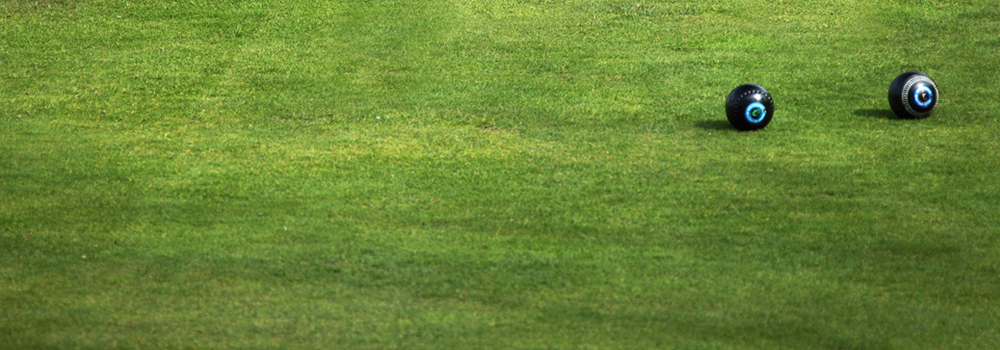
For those wishing to learn more about their greens, and the problems to be dealt with, you might wish to have a look at the Pitchcare Forum where there is a specific section on bowls matters - Pitchcare Forum.
Key Tasks for April

- Scarify the green
- Solid tine spike
- Topdress
- Overseed
- Apply a spring fertiliser
- Apply wetting agent, if required
Mowing should be more frequent now, at least 2-3 times per week. These frequencies can often be dictated by budget and the club's level of play. The height of cut should be decreasing until the optimum cutting height is achieved for the standard of play, usually between 4mm and 5mm.
Do not be tempted to cut any lower, especially if members are complaining the green is too slow. Cutting below 3.5 mm is really asking for trouble. Cutting off too much leaf material will put the sward under stress. The grass plant needs its leaves to manufacture energy for growth.
Brushing/switching. Keeps the green clean and removes any dew or surface water. Keeping the surface dry will help stop the spread of disease. There are a number of dragmats or brushes that can be used. See the Pitchcare shop for details - brushes/drag mats
Aeration is important to improve the surface and subsurface drainage capacity of the green. Aeration also increases gaseous exchanges in the soil. It is important to use the right aeration equipment as you do not want to disturb the surface too much prior to the playing season.
Do not carry out aeration when there is the likelihood of smearing or causing damage to the surface. The condition of the green and what budgets you have may decide what type of aeration programme can be achieved
Verti-cutting: fortnightly. Verti-cutting helps to thin the sward, removes weak grasses, helps the sward to stand up vertically and encourages tillering.
Fertilising: Ideally, you should have conducted a soil analysis of your soil profile to ascertain the nutrient status of your green. This will help you decide on what fertiliser products to buy and apply. Ensure you apply at the recommended rates and do not overdose the green or overlap when applying the products. There are plenty of spring fertiliser products available to meet your needs.




Spring represents the best time to undertake a broad spectrum chemical soil analysis. The subsequent report will help turf managers to make factual based decisions on further nutritional requirement throughout the year. Deficiencies can then be addressed through granular or foliar fertilisers, thus maximising plant health and surface quality.
The role of potassium is increasingly being understood with respect to water mobilisation, and recent research indicates an application of potassium in the spring helps to guard against drought stress in the summer.
Since the enforcement of the clean air act, we see that sulphur levels are often low in many soils. Sulphur is a vital element for plant health, playing a key role in protein production which drives immune response in many organisms. Proteins are created from amino acids, many of which are sulphur based. Ensuring adequate sulphur levels in the spring, with an application of a granular fertiliser containing ammonium sulphate, will help to boost levels as the season starts.
Be sure to check and compare the nutritional analysis lists on all your fertilisers; looking at values other than NPK will reveal additional nutrients in the mix which may be of benefit - Fertilisers
Biostimulants
Increasingly the role of biostimulants is being recognised by turf managers at all levels:
- Carbon sources: for example BioMass sugar facilitates a balancing of the carbon to nitrogen ratio in the soil. This allows both microorganisms and plants to maintain this vital ratio within their systems when up-taking the nutrient, better facilitating nitrogen efficiency and utilisation. Simply put, sugars are essentially soil life and plant carbon fertilisers, which can be applied regularly to rootzones throughout the year.
- Seaweed: when applied as a liquid foliar treatment, contains a variety of plant hormones, enzymes, vitamins and trace elements which should be utilised to prime plant defences by eliciting better responses to stress events and provides a general stimulator of plant metabolic function. Liquid seaweed also acts as a chelating agent for nutrients. Seaweeds should be used on a regular basis to prime plant defences and stimulate efficient plant function.
- Humates: are naturally occurring core components of healthy soils, produced as a by-product of organic decomposition. Humate substances act as a soil structure improver, microorganism habitat, microorganism stimulant, nutrient bank improver, nutrient carrier, chelator. Humates can be applied throughout the year to increase nutrient uptake and efficiency, boost soil biology function and habitat, and increase the nutrient holding capacity of the soil.
Wetting Agents
Often wetting agents are applied too late in the season to be made the best use of. Quite often, the use of wetting agents will be approached in a similar vein to disease management i.e. waiting for symptoms before treating the problem. Once dry patch areas are visible, the chemistry within the soil necessitates the need for a curative wetting agent to strip away the organic proteins causing the water repellence; these wetting agents can be quite harsh to soil ecology and, as a result, there are not too many on the market.
The majority of wetting agents contain two molecules which act independently from each other for different effects:
Penetrant molecule: a penetrant wetting agent is designed to move water away from the surface and down through the profile.
Polymer molecule: a polymer molecule is designed to capture water and hold it lower down in the profile.
The majority of wetting agents will utilise both molecules, the penetrant to firstly move water away from the surface where it may contribute towards surface wear or just simply evaporate; the polymer molecule to then capture that water further down the profile and retain it for plants to uptake.
This strategy requires a build-up of the molecules and subsequent water cycling processes ahead of dry periods to help PREVENT the onset of dry conditions. As a result, to gain the best effect from wetting agents, they should be applied monthly through the growing season starting in the spring.

Keep an eye on fungal disease attack and use approved fungicides to treat infected areas. The typical types of diseases you may come across are:
- Fusarium Patch
- Red Thread
- Fairy Rings
- Anthracnose
Some of the damage symptoms that insects and pests can cause are very similar to those caused by diseases, so it is very important to correctly diagnose the problem before treatment is applied.
More information on these and many others can be found here: https://www.pitchcare.com/useful/diseases.php
The normal cultural control for disease prevention should be adopted, such as monitoring weather conditions for peak periods, removing morning dews and avoiding excessive applications of nitrogen. Increasingly, turf managers will find that many of the weapons in the fungicidal armoury are likely to become less available in the years to come, particularly in respect to curative contact type active ingredients.
Under this climate, it will be critically important that turf managers at all levels are equipped with the knowledge and understanding to maximise the use of systemic fungicides for best effect. This integrated approach will go hand in hand with reference to historical occurrence records and disease forecasting technologies, prior to visible signs of infection, and will be the only method of chemical control. Increasingly, turf managers will have to manage disease outbreaks preventatively, by using cultural controls and maintaining plant health and eliciting plant resistance through careful nutritional applications. The key elements in this instance being calcium, phosphite and iron.
The wisest of individuals will take early opportunities to seek out and engage with organisations and associations, when learning and professional development opportunities present themselves.
More advice and information is available on the website – Fungicide Programmes
Worms can also be very active at this time of the year so treatments can be carried out, if needed; the use of Carbendazim is the only active ingredient for controlling worms, for the time being. All personnel should be suitably qualified in the application of chemicals - Carbendazim withdrawal timescale
Moles can be attracted to areas where worms are prevalent; these need to be treated as they can cause a lot of damage to outfields and other surrounds.
Pests
Many areas are suffering the effects of chemical insecticide withdrawal over the past year, with chafer grubs and leatherjackets causing problems for turf managers, either through their direct action on the grass plant or through the indirect damage of mammals and birds seeking out a meal.
There are no effective treatments for the control of these insect pests in the spring control should be carried out at the correct time of the year with entomopathogenic nematodes. Nematode treatments are very successful when applied within the correct application windows which respect the life cycles of both pest and control.
More information and advice is available on the website – Chafers and Leatherjackets.
You should have had your mower serviced and sharpened ready for the new season.
- Keep machines overhauled and clean
- Inspect irrigation equipment for leaks

Our Lantra Accredited Bowls Green Maintenance Course is now available as an online course.
Now you can learn about maintaining a bowls green in the comfort of your own home and in your own time. This newly developed course consists of a number of videos with assessment questions, and an accompanying hard copy Course Manual. The Online Course is Lantra accredited and provides you with all the basic knowledge required to maintain a green over a 12 month period. There is also the option of attending a one day practical course.
Pitchcare is the only provider of LANTRA accredited training courses in the maintenance of Bowls Greens.
We can also arrange Lantra accredited training on site to groups of 6 – 10 people. Email Chris Johnson for information.
The Course Manual is available for purchase separately.
- Carry out any repairs to ditches, paths, gates, floodlights and other building features
- Inspect and clean out drain outfalls and gullies. Replace and level up drainage ditch materials
- Inspect and clear away any litter or debris (high winds may blow debris onto greens)
- Check and service floodlighting systems; ensuring they are ready for the new playing season
- It also important to replace any worn tines on your aeration equipment
- Ensure you have organised and ordered the appropriate materials from suppliers, don't leave it too late! There should be a supply of topdressing and seed as well as your chosen fertiliser. Possibly some wetting agent and any chemical controls that could be needed at short notice.


